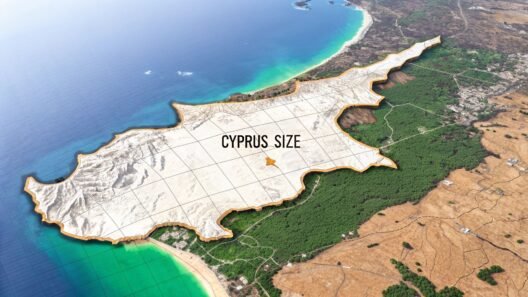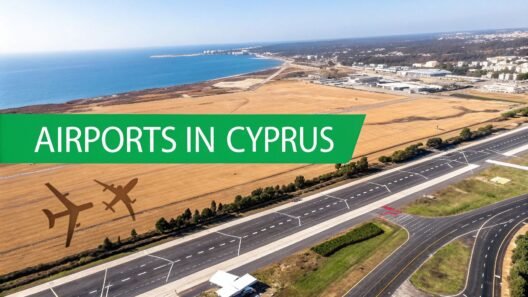Right, let's get one of the biggest questions out of the way first. In Cyprus, you drive on the left-hand side of the road, the same as you would in the UK. For British visitors, this is fantastic news and makes the whole idea of hiring a car feel much less daunting.
Your instincts for pulling out of junctions and navigating roundabouts will serve you well here. It’s a real ‘home from home’ driving experience.
Getting to Grips with Cypriot Roads
For anyone visiting from the UK, Ireland, or Australia, landing in Cyprus and hopping into a hire car brings an immediate sense of relief. The steering wheel is on the right, and the traffic flows on the left. This isn't just a happy coincidence; it's a direct legacy of British administration, which shaped much of the island's infrastructure long before its independence in 1960. If you're curious about the history of left-hand driving, TheAutopian.com has some fascinating insights.
This shared practice gives you a brilliant head start. Instead of constantly second-guessing which lane you should be in, you can relax and focus on soaking in the gorgeous coastal views and dramatic mountain landscapes.
Why This is a Game-Changer for Your Holiday
Knowing that you’ll be on the correct side of the road is more than just a piece of trivia. It means that most road signs, junctions, and general traffic flow will feel familiar and intuitive. That said, it's important not to get too complacent. Local driving habits and a few specific rules can still catch you out if you're not paying attention.
The Bottom Line: Driving on the left makes Cyprus one of the easiest European destinations for UK drivers to explore by car. That shared foundation removes a huge layer of stress, letting you hit the road with confidence from the moment you leave the car hire depot.
This simple image is a great visual reminder of the most important rule to remember on Cypriot roads.
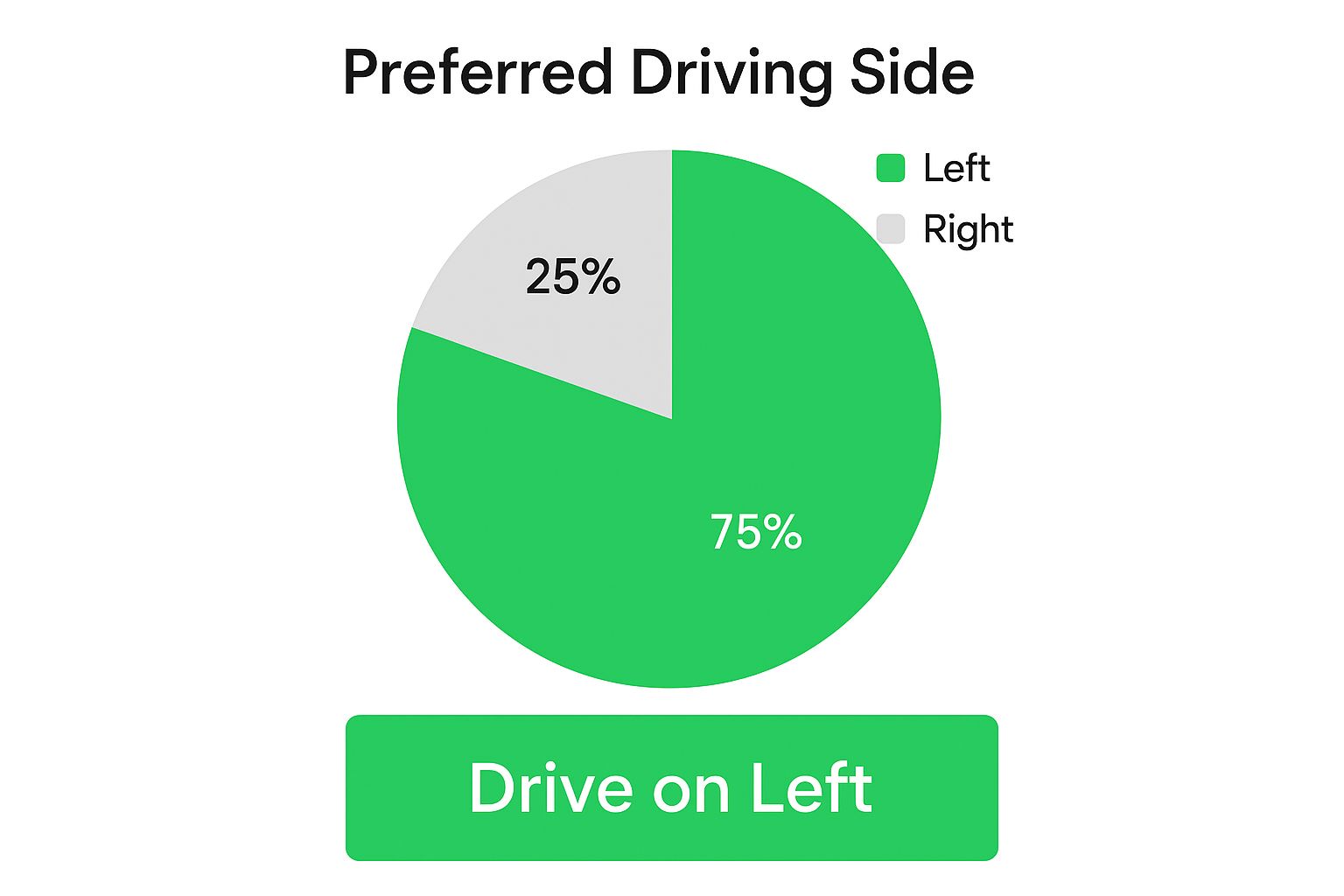
While keeping left is the golden rule, there are a few subtle differences between driving here and back home. To help you prepare, here’s a quick comparison of what to expect.
Key Driving Differences UK vs Cyprus
| Feature | United Kingdom | Cyprus |
|---|---|---|
| Driving Side | Left | Left |
| Speed Limits | In MPH | In KM/H |
| Motorway Speed | 70 mph (approx. 112 km/h) | 100 km/h (approx. 62 mph) |
| Rural Road Speed | 60 mph (approx. 96 km/h) | 80 km/h (approx. 50 mph) |
| Urban Speed | 30 mph (approx. 48 km/h) | 50 km/h (approx. 31 mph) |
| Use of Horn | Restricted use, mainly for warnings | Used more frequently, often for greetings or to signal presence |
| Roundabouts | Standard practice | Common, but approach with caution as rules can be loosely followed |
As you can see, the core principles are identical, but the key differences, especially the speed limits in KM/H, are crucial to remember. Getting this right will help you avoid any unwanted fines and keep your driving experience smooth and enjoyable.
Here is the rewritten section, crafted to sound like it was written by an experienced human expert.
Getting a Feel for the Roads in Cyprus
Right, so you know to stick to the left. That's a great start and will feel familiar if you're coming from the UK. But here’s the thing about driving in Cyprus: the roads have their own unique personality. One minute you could be cruising down a modern, multi-lane motorway between Limassol and Paphos that feels just like a dual carriageway back home. The next, you're squeezing through the impossibly charming, stone-paved lanes of a mountain village, where every inch matters.
This dramatic shift is a huge part of the island's magic, but it does mean you need to keep your wits about you. The switch from high-speed driving to slow, careful negotiation can happen in the blink of an eye. Realising this is the key to truly understanding what it takes to drive here; it's about much more than just remembering which side of the road to be on.
From Smooth Motorways to Winding Mountain Passes
The main A-class motorways are a breeze to navigate, but the real Cypriot driving adventure starts the moment you turn off onto the smaller B-roads or the even smaller unclassified tracks. This is especially true if you're heading up into the Troodos Mountains or exploring the wilds of the Akamas Peninsula. Expect roads that are steep, winding, and often a lot narrower than you’d bargain for.
Out here, a different set of unwritten rules takes over. Here's what I've learned from years of driving on the island:
- Expect the Unexpected: Cypriot drivers can be… let's call it 'assertive'. You might find indicators are used less than you're used to, and people can stop suddenly. Adopting a defensive driving mindset will serve you well.
- Watch for Four-Legged Hazards: Don't be surprised to round a bend and find a herd of goats casually making their way across the road. On blind corners, it's always wise to ease off the accelerator.
- Use Your Horn Wisely: This isn't like the UK, where a horn is mostly for emergencies. A quick, friendly toot before a blind corner is a common and accepted way to let others know you're coming.
The real skill is in how you adapt. One moment you're breezing along the beautiful coastline; the next, you're carefully guiding your car down a street in Lefkara village that feels barely wider than your wing mirrors.
Ultimately, getting to grips with Cypriot roads is about more than just staying left. It’s about respecting the rhythm of the place you’re in, trying to anticipate what other drivers might do, and constantly adjusting your speed to match the conditions. Do that, and you'll be able to soak in all that stunning scenery without any nasty shocks.
Essential Cyprus Road Rules You Must Know
Alright, so you know you'll be driving on the left-hand side. That's the first hurdle cleared. But to really get around Cyprus like a local and avoid any unwanted trouble, you need to get your head around a few specific rules. Some of these are quite different from the UK, and knowing them can be the difference between a fantastic road trip and one spoiled by an expensive fine.
The first thing you’ll notice is the speed limit signs. They’re all in kilometres per hour (km/h), not miles per hour. Your hire car will have a km/h speedometer, but it’s a mental switch you need to flick as soon as you get behind the wheel.
Key Regulations for UK Drivers
Beyond the speed, there are a few non-negotiable rules that the police take very seriously. Think of these less as guidelines and more as absolute must-dos for staying safe and on the right side of the law.
- Seatbelts Are a Must: This isn't optional. Everyone in the car, front and back, has to be buckled up.
- No Phones While Driving: You cannot use a handheld mobile phone at the wheel. It’s illegal. If a call is essential, you must have a proper hands-free kit.
- Winter Headlight Rule: From the start of November to the end of March, you must use dipped headlights from half an hour after sunset until half an hour before sunrise.
A crucial point to remember is the drink-driving limit. It's much stricter here than back in the UK. The limit in Cyprus is just 22 microgrammes of alcohol per 100 millilitres of breath. For comparison, that's significantly lower than the 35 microgrammes limit in England and Wales. Honestly, the best and only advice is to not drink at all if you're the designated driver.
You'll find most road signs are a breeze to understand, as they're typically in both Greek and English, particularly on the main roads and motorways. Roundabouts work the same way as they do in the UK—give way to traffic from your right—but always approach them with a bit of caution, as local driving styles can sometimes be… spirited.
And before you even set off, it's worth sorting out how you'll charge your sat nav and phones. Check out our handy guide on what plugs are used in Cyprus to make sure you're prepared.
Your Guide to Renting a Car in Cyprus
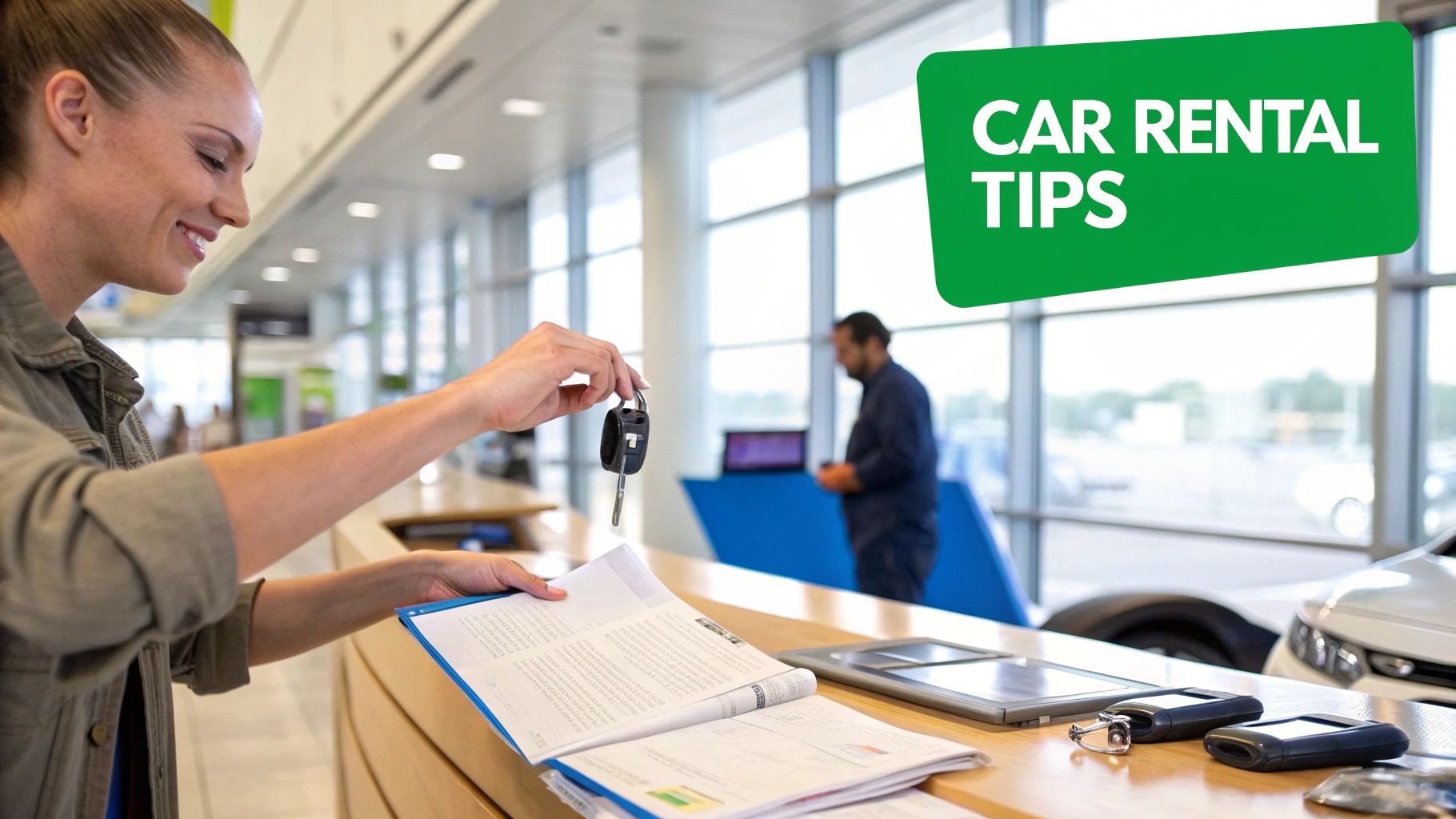
Getting your own set of wheels is the best way to truly unlock Cyprus. It gives you the freedom to move beyond the tourist trail, discovering hidden coves and sleepy mountain villages on your own schedule. Since you’ll be driving on the left, just like at home, the biggest hurdle is the rental process itself. Luckily for UK visitors, it’s all pretty straightforward.
Before you head to the rental desk, make sure you have everything you need. You'll need your valid UK photocard driving licence, your passport as proof of ID, and a credit card to cover the security deposit. A word of warning: most rental companies insist on a credit card for the main deposit and won't accept a debit card, so double-check you have one with a sufficient limit.
Age and Vehicle Choices
Generally, the minimum age to rent a car here is 21, but many agencies prefer drivers to be 25 or older. If you're under 25, expect to pay a "young driver surcharge." This can be a hefty daily fee, so it’s something to factor into your budget.
Picking the right car is all about matching the vehicle to your holiday plans. A small, zippy hatchback is ideal for navigating the narrow, winding streets of Paphos Old Town or Larnaca. But if you’re planning on exploring the rugged beauty of the Akamas Peninsula, a 4×4 isn't just a suggestion—it's essential for handling those rough, unpaved tracks.
One thing to remember when booking is that you’re usually reserving a car category, not a specific make and model. So, you might book a Ford Focus but end up with a very similar Opel Astra. This is completely normal across the car hire industry.
Insurance can feel a bit daunting, but it doesn't have to be. Your rental will come with a basic Collision Damage Waiver (CDW), but for complete peace of mind, it’s worth looking at the optional extras. To get a handle on what's available and find a great deal, have a look at this guide on cheap car hire in Cyprus – it’s great for avoiding any nasty surprises.
A Guide to Parking and Fuelling Up in Cyprus
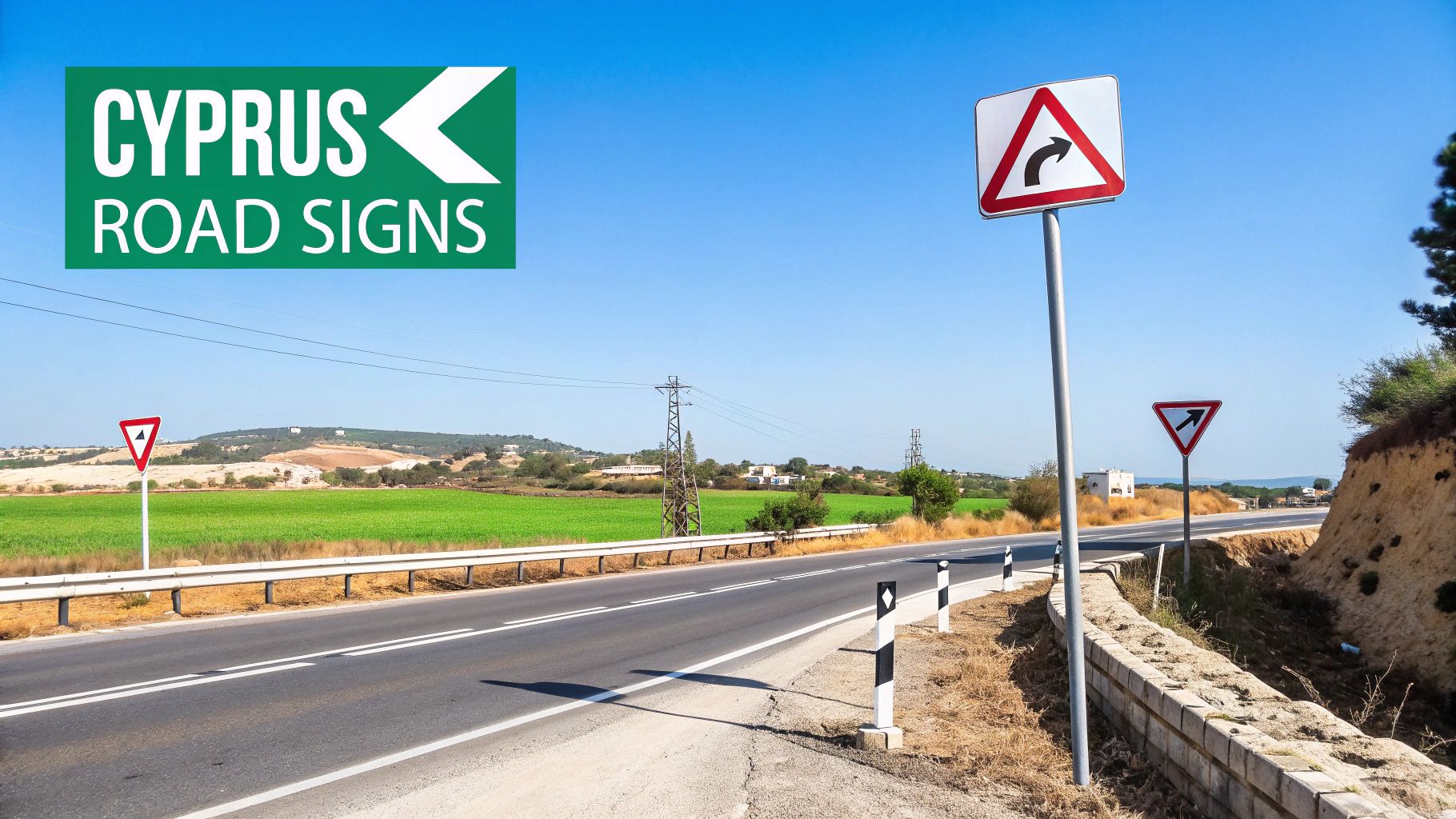
Getting to grips with the local driving style is half the battle won, but knowing the ins and outs of everyday tasks like parking and filling up the tank will make your Cypriot road trip seamless. Especially in popular towns like Paphos or Limassol, figuring out the parking system is key to avoiding an unwelcome fine.
Finding a Parking Spot
Much like in the UK, Cyprus uses a familiar colour-coded system on its kerbs to signal parking rules. Here’s what to watch for:
- Double yellow lines are a clear sign of no parking at any time. Don't even think about it!
- A single yellow line means there are restrictions in place. You'll need to look for a nearby sign to see what the permitted hours are for parking.
In most town centres, you’ll find that on-street bays and designated car parks operate on a pay-and-display basis. It’s a straightforward system: just buy a ticket from the machine and display it clearly on your dashboard.
Getting Fuel for Your Car
Petrol stations are dotted all over the island and are generally easy to navigate. During normal working hours, most are fully attended. Just pull up to a pump, let the attendant know how much fuel you'd like (or just ask for a full tank), and they'll handle it for you. You can pay them directly with cash or a card. Simple.
Things change a bit after hours. Many stations switch over to self-service, pre-pay pumps, so it's a good idea to have a card handy if you're planning a late-night drive.
A Word of Warning: Before you even think about grabbing the pump, double-check what type of fuel your hire car takes. Putting the wrong one in is a costly and holiday-ruining mistake. The pumps are clearly marked, usually with Unleaded 95 (petrol) or Diesel.
Once you’ve got these simple logistics down, you’ll find that driving in Cyprus is a breeze, letting you focus on enjoying the stunning scenery.
Driving Safely with Local Insights
Driving in Cyprus is more than just knowing the official rules of the road; it's about getting a feel for the local driving culture. To have a smooth experience, you'll want to cultivate a good dose of situational awareness and adopt a defensive mindset. Local habits can sometimes feel a bit unpredictable to outsiders—think less indicator use or the occasional sudden manoeuvre—so your best friend is always leaving plenty of space between you and the car in front.
This need for extra vigilance is something to take seriously. Between 2008 and 2015, Cyprus saw 67 road deaths per 1 million inhabitants, a figure that was noticeably higher than the EU average of 51 at the time. While things have certainly gotten better since then, it’s a good reminder to always drive with care. You can dig deeper into these Cypriot road safety statistics on Rhinocarhire.com.
Handling Unique Hazards and Emergencies
Beyond the traffic itself, Cyprus has a couple of unique environmental quirks to watch out for. During long dry spells, a fine layer of dust settles on the roads. The moment the first drops of rain fall, this dust can turn the surface incredibly slippery, almost like black ice. It catches many drivers off guard, so if you feel a drizzle start, ease off the accelerator immediately.
Knowing who to call in an emergency gives you real peace of mind. Of course, driving is just one piece of the puzzle, and you can get the full picture by reading our guide on whether Cyprus is a safe destination.
For any serious situation—be it an accident or a medical issue—you can dial 112. This is the pan-European emergency number that will connect you to the police, ambulance, or fire services.
What To Do in a Minor Accident: If you get into a small fender-bender and thankfully nobody is hurt, the local custom is pretty straightforward. Pull over to a safe spot, pop on your hazard lights, and exchange insurance and contact information with the other driver. It’s also a really good idea to snap a few photos of the scene and any damage to the vehicles before you move them.
By staying alert and being prepared for these local conditions, you'll be ready for whatever the Cypriot roads have in store, making sure your trip is both safe and enjoyable.
Common Questions About Driving in Cyprus
Alright, let's tackle a few common questions that pop up before visitors get behind the wheel. Having these answers in your back pocket will help you feel much more relaxed when you pick up your hire car and start exploring.
Do I Need an International Driving Permit for Cyprus?
Good news – probably not! If you hold a valid UK photocard driving licence, that’s all you’ll need to rent and drive a car legally in the Republic of Cyprus. The process is refreshingly straightforward for British tourists. Just make sure you always have your licence with you.
Are Road Signs in Cyprus in English?
Yes, they are. You'll find that road signs are almost always in both Greek and English, especially on the motorways and main roads. In popular tourist spots like Paphos, Limassol, and Larnaca, this dual-language signage makes getting around a breeze, even if you're new to the island.
A Quick Word on Northern Cyprus: This is a big one that often catches people out. Taking a hire car from the south (the Republic of Cyprus) into Northern Cyprus is a major no-go for most rental companies. Your insurance cover will likely be voided the second you cross the UN buffer zone. If visiting the north is on your agenda, you absolutely must speak with your hire company first and likely arrange separate insurance at the border crossing.
Can I Take My Rental Car to Northern Cyprus?
This is where you need to be really careful. The vast majority of car hire companies in the south will not allow their vehicles to be taken into Northern Cyprus. Doing so will almost certainly invalidate your insurance, meaning you'd be personally responsible for any damage or accidents. Always, always check the cross-border policy in your rental agreement before even thinking about it.
At SayCyprus, our passion is helping you uncover all the incredible spots this island has to offer. We create guides packed with local knowledge to make your trip truly unforgettable. You can find more of our tips and destination guides at https://www.saycyprus.com.










